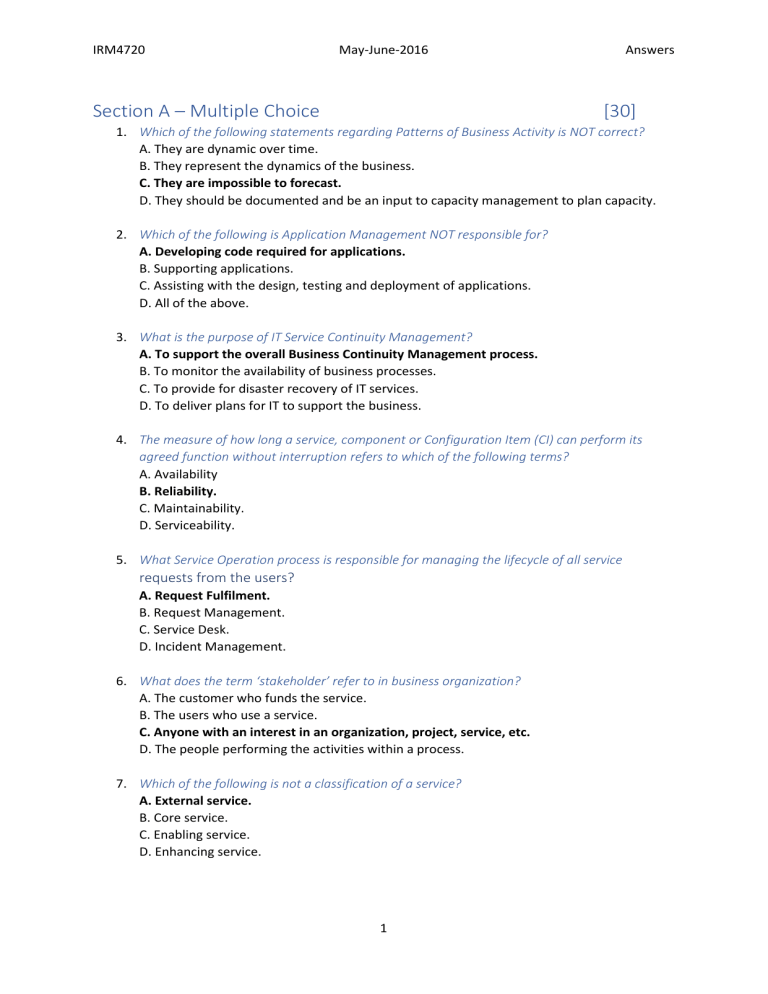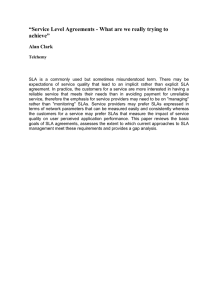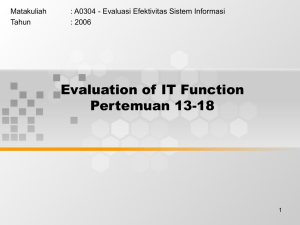
IRM4720 May-June-2016 Section A – Multiple Choice Answers [30] 1. Which of the following statements regarding Patterns of Business Activity is NOT correct? A. They are dynamic over time. B. They represent the dynamics of the business. C. They are impossible to forecast. D. They should be documented and be an input to capacity management to plan capacity. 2. Which of the following is Application Management NOT responsible for? A. Developing code required for applications. B. Supporting applications. C. Assisting with the design, testing and deployment of applications. D. All of the above. 3. What is the purpose of IT Service Continuity Management? A. To support the overall Business Continuity Management process. B. To monitor the availability of business processes. C. To provide for disaster recovery of IT services. D. To deliver plans for IT to support the business. 4. The measure of how long a service, component or Configuration Item (CI) can perform its agreed function without interruption refers to which of the following terms? A. Availability B. Reliability. C. Maintainability. D. Serviceability. 5. What Service Operation process is responsible for managing the lifecycle of all service requests from the users? A. Request Fulfilment. B. Request Management. C. Service Desk. D. Incident Management. 6. What does the term ‘stakeholder’ refer to in business organization? A. The customer who funds the service. B. The users who use a service. C. Anyone with an interest in an organization, project, service, etc. D. The people performing the activities within a process. 7. Which of the following is not a classification of a service? A. External service. B. Core service. C. Enabling service. D. Enhancing service. 1 IRM4720 May-June-2016 Answers 8. What is a Configuration Item (CI) A. Business assets that support critical business processes. B. Anything necessary in the delivery of technical services. C. Any asset of an organization D. Anything that is under the control of Configuration Management 9. Which of the following refers to the term Service Metric? A. The end-to-end measurement of a service. B. The measurement of customer satisfaction C. The response time at the Service Desk. D. The measurement of the underlying processes that support the service. 10. Which of the following is NOT a value to business of the Service Strategy stage of the service lifecycle? A. Effectively design new and changed services. B. Enable an understanding of what types and levels of services makes its customer successful? C. Enable the activities performed by the service provider to be linked to business outcomes enabling the service provider to be seen as contributing to the value of the business. D. Facilitate functional and transparent communications between the customer and the service provider so that both have a consistent understanding of what is required and how it will be delivered. 11. Which of the following does service automation improve? A. Capabilities and resources. B. Functions and processes. C. Utility and warranty. D. Value and cost. 12. What are the three types of metrics as defined within Continual Service Improvement (CSI)? A. Process, terminology, service B. Program, Project and Personnel. C. Organization, Business, Customer. D. Baseline, benchmark, audit. 13. Which of the following is the best description of the Service Desk function? A. The single point of contact for all operational issues from users. B. The single point of contact for all business changes. C. The single point of contact for vendors to submit incidents. D. The single point of contact between customers and IT. 14. In which stage of the service lifecycle include Service Catalog Management, Supplier Management and Information Security Management? A. Service strategy. B. Service design. C. Service transition. D. Service operation 2 IRM4720 May-June-2016 Answers 15. Which of the following statements regarding Problem Management are correct? 1. When resolutions to problems require a change, they do not have to go through Change Management. 2. Problem Management stores information about the underlying errors and workarounds in the Known Error Database (KEDB) 3. Problem categorization and incident categorization are most likely to be identical. 4. Problem Management activities are entirely reactive. A. 1, 3 and 4 B. 2 only C. 4 only D. 2 and 3 only 16. Which of the following is the best description of IT Services Management? A. A means of delivering value to customers by facilitating outcomes customers want to achieve without the ownership of costs and risks. B. The implementation and management of quality IT services that meet the needs of the business. C. Both of the above. D. None of the above. 17. Services facilitate what? A. Risks. B. Revenue. C. Outcomes. D. Costs. 18. Providing a consistent and single source of information for all services that are in operation or are prepared to be run operationally is the responsibility of which process? A. Service Strategy. B. Service Level Management. C. Service Catalog Management. D. Service Operation. 19. What does the term ‘rights’ refer to? A. The permission granted to a user or role. B. Information about a user that distinguishes one individual user from another. C. The level or extent of a service’s functionality that a user is entitled to. D. None of the above. 20. The main output of service operation is which of the following? A. Tested services to continual service improvement. B. Service performance reports to service design. C. Service operations package to service transition. D. Service performance reports to continual service improvement. 3 IRM4720 May-June-2016 Answers 21. Which service operation function is responsible to be the custodian of information regarding the infrastructure? A. Application management. B. Facilities management. C. Configuration management. D. Technical management. 22. To what does the statement” Ensures that policies and strategy are actually implemented, and that required processes are correctly followed” refer? A. Assurance B. Governance. C. Strategy. D. Audit. 23. The two sub-functions of IT Operation Management are which of the following? A. Request Management and Data Centre Management. B. Application management and Technical Management. C. Operations control and facilities management. D. Facilities Management and request Management. 24. What would be the next step in the Continual Service Improvement Model / Approach after? 1. What is the vision? 2. Where are we now? 3. Where do we want to be? 4. How did we get there? 5. Did we get there? A. How much did it cost? B. How do we keep the momentum going? C. What was the value on investment? D. What is the Total Cost of Ownership (TCO)? 25. The purpose of Access Management is what? A. To define security policies to be followed. B. To provide the right for users to be able to use a service or group of services. C. To audit security throughout the service provider organization. D. To ensure that access to services is available to all who ask. 26. Which of the following activities is carried out in the “Where do we want to be” step of the continual service improvement model? A. Aligning the business and IT strategies. B. Implementing service and process improvements. C. Creating a baseline. D. Defining measurable targets. 4 IRM4720 May-June-2016 Answers 27. What is a service-based Service Level Agreement (SLA)? A. An SLA between service providers. B. An SLA for a single customer for all services for that customer. C. An SLA for a single service applicable to all customers of that service. D. An SLA between two parts of the same organization. 28. Which stage of the service lifecycle is responsible for the design of new and changed services? A. Service Level Management. B. Service transition. C. Service strategy. D. Service design. 29. What is a customer-based Service Level Agreement (SLA)? A. An SLA between customers. B. An SLA for a single customer for all services for that customer. C. An SLA for a single service applicable to all customers of that service. D. None of the above. 30. Management, organization, processes and knowledge refer to what type of service asset? A. Functions. B. Outcome support. C. Resources. D. Capabilities. Section B – Matching [25] Match the term from column A with its correct description from column B Column A Column B 1 Users Q Those that use a service on a day-to-day basis. 2 Service Provider I An organization supplying services to one or more internal customers or external customers. 3 Process Practitioner H The role responsible for carrying out process activities. 4 Function C Refers to the people and the tools they use to carry out one or more processes or activities. 5 Service Asset S Any resource or capability of a service provider. 6 Service Owner O The role responsible for the initiation, transition and ongoing maintenance of a particular service. you need to own in 7 Business Case P A decision support and planning tool to justify a particular course of action. 8 Warranty B Promise or guarantee that a product or service will meet its requirements. 9 Utility N The functionality offered of a product or service to meet a particular need. 10 Vital Business Function (VBF) U The part of a business process that is critical to the success of the business VBS ya shumela venda its very critical 11 Service Level Agreement W An agreement between an IT service provider and a (SLA) customer. 5 IRM4720 May-June-2016 12 Operational Level Agreement (OLA) R 13 Service Provider I 14 CSI register V 15 Governance K 16 Baseline 17 Key Performance Indicator (KPI) 18 Incident J X 19 Known Error Database (KEDB) 20 Configuration Management System (CMS) 21 Change Model F 22 Definitive Media Library (DML) 23 Remediation Planning M 24 Maintainability G 25 Underpinning Contract (UC) A L T D E Answers An agreement between an IT service provider and another part of the same organization that assists in the provision of services. service desk na incident OLA An organization supplying services to one or more internal customers or external customers. telkom, ubuntu, sonke Part of the SKMS, it is used to record identified improvement opportunities. Ensuring that policies and strategy are actually implemented, and that required processes are correctly goverment i pfana na followed mafhungi a policies, Used to establish a basis for later comparison strategy to implemrnt The most important set of metrics to gauge performance. An unplanned interruption to an IT service or a reduction in the quality of an IT service or a potential disruption to an IT service. The storage location for known errors and their workarounds. A set of tools and databases to manage a service providers configuration data and their relationships. A predefinition of the steps that should be taken to handle a type of change in an agreed way. A storage location for definitive media assets. A plan defining the steps required to restore business processes following a disruption. A measure of how quickly and effectively a service, component or CI can be restored to normal working after a failure. A agreement between an IT service provider and a third ndi SWonke na >>> vodacom party. 6 IRM4720 May-June-2016 Section C - Short Paragraph Type Questions Answers [45] 1. Within service level management are three specific types of service level agreements (SLA’s). List the three types of service level agreements and describe each one. (6) - Service-based SLA’s – Covers one service for all customers. - Customer-based SLA’s – Is an agreement with one customer, covering all the services used by this customer. - Multi-level SLA’s – Are defined according to the organization of the customer using some kind of inheritance with overall definitions with relevance for all subordinate levels. This SLA focuses on the organization of the customer. All services and their interrelationships with subordinate services are used when defining the multi-level service level agreement structure. 2. Briefly describe what ITIL is. (4) - ITIL “Information Technology Infrastructure Library” is an integrated set of best-practice processes for delivering IT services to customers. - The primary focus is to maximize value to customers (the business) by aligning IT resources with business needs. - At its core is the basic idea that value is provided in the form of business-aligned IT Services. - ITIL contains detailed process descriptions, flows, success factors, metrics and implementation guidance that organizations can adapt to work in their environment. 3. A service is defined as “a means of delivering value to customers by facilitating outcomes customers want to achieve without the ownership of specific costs and risks” Services have specific characteristics. Briefly explain the following two characteristics. 3.1. Services create value. - Services create value of some form for the customer. - If the service has no associated value, there will be no customers. - If there were no value, you would not need the service. - Cell phone service and Internet (2) 3.2. Services remove the risk of ownership from customers. (2) - Customers want to achieve some outcome without being forced to own the technology, knowledge or underlying components that make up that service. - IT provides the service, assumes ownerships of the costs, and maintains the required knowledge. 4. Briefly mention the RACI authority matrix. (5) - It is used to map the Process activities to the Roles involved in their execution. Responsible – The Person who is going to do the work/activity – Ex: Team Member Accountable – The person who owns the Activity - Ex: Project Manager Consulted – The person who may provide inputs for the Activity – Ex: Technical Architect Informed – The person who needs to be informed of the work/activity – Ex: Project Sponsor 7 IRM4720 May-June-2016 Answers 5. Briefly explain what the RACI model ensures. - It ensures that end-to-end accountability is identified for the process activities. - It also ensures that gaps are identified and can be corrected. (2) 6. A RACI model has potential problems that should be understood. Briefly mention these potential problems. (3) - A process or activity can only have one person accountable, Sharing accountability can result in no accountability. - Responsibilities for closely related processes must be properly identified to ensure that the process relationships remain intact. - Individual agendas or goals may get in the way of satisfying the overall goals of the process. 7. ITIL consist of five core volumes. Briefly explain the following two. 7.1. Service Transition. (3) - It focuses on building, validating, and delivering new and changed services to customers. - It involves transitioning a service from design to an operational service. - It is focused on reducing risk during transition, as well as improving ongoing control of the service. 7.2. Service Operation. (3) - It focuses on the day-to-day care and feeding of services. - Purpose is to coordinate and carry out the activities and processes required to deliver and manage services at agreed levels to business users and customers. - Responsible for the ongoing management of the technology that is used to deliver and support services. 8. You have learned that a process is a set of structured activities to accomplish a specific objective. Identify the characteristics of a process using MaSsaCRe as a mnemonic. - Must be Measurable - Must have a Specific Output - Must deliver value to a Customer - Must Respond to a trigger 8 (2) IRM4720 May-June-2016 Answers 9. Continual Service Improvement (CSI) states four specific reasons to measure. In the diagram below, Identify the four reasons to measure. (4) 9.1. 9.2. 9.3. 9.4. To validate To Direct To Justify To Intervene 10. A process is defined as a structured set of activities designed to accomplish a specific set of objectives. Mention at least four characteristics of a Process. (4) - Measurable - Specific Output - Customer - Respond to a trigger 11. Every change must be evaluated to answer seven questions. The seven questions reflect the 7 Rs of change management. Briefly explain at least five of the seven questions. (5) - Who RAISED the Change? – This identifies the person that requested the change. - What is the REASON for the change? – A valid business reason should be provided. - What RETURN will the change deliver? – What is expected from the change. - What RISKS are there is we do or do not carry out the change? – Risk assessment must be done - What RESOURCES will be required to perform this change? – Funding, people and technology. - Who is RESPONSIBLE for this change being performed? – Who will perform the activities. - What RELATIONSHIPS are there between this and other changes? – What will this impact. ---------------- END --------------- 9


